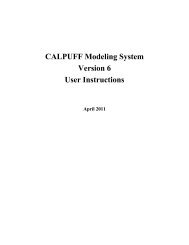Volume 1 - The Atmospheric Studies Group at TRC
Volume 1 - The Atmospheric Studies Group at TRC
Volume 1 - The Atmospheric Studies Group at TRC
Create successful ePaper yourself
Turn your PDF publications into a flip-book with our unique Google optimized e-Paper software.
T (ºK)<br />
g (m/s 2 )<br />
temper<strong>at</strong>ure<br />
gravit<strong>at</strong>ional acceler<strong>at</strong>ion<br />
<strong>The</strong> constants A, B, and C have suggested values of 0.2, 2.5, and 8, respectively.<br />
Adjustments to He<strong>at</strong> Flux in Convective Mixing Height<br />
dh<br />
− ws<br />
dt<br />
=<br />
(<br />
( w'<br />
θv'<br />
) − ( w'<br />
θv'<br />
)<br />
2<br />
2<br />
h<br />
Cu*<br />
T γg<br />
+<br />
(1 + 2A)<br />
h − 2BκL<br />
(1 + A)<br />
h − BκL<br />
th<br />
)<br />
γ<br />
(3-35)<br />
where (w’θ v ’) th is the threshold kinem<strong>at</strong>ic he<strong>at</strong> flux <strong>at</strong> the surface.<br />
Observed positive values of the surface buoyancy flux over the Gulf of Mexico<br />
during summer time when the overw<strong>at</strong>er mixing layer is <strong>at</strong> equilibrium suggest th<strong>at</strong><br />
the warm surface destabilizing effect is balanced by dissip<strong>at</strong>ion.<br />
Although the equilibrium might be owing to various processes such as turbulence<br />
dissip<strong>at</strong>ion, radi<strong>at</strong>ive cooling <strong>at</strong> the top of marine str<strong>at</strong>ocumulus layer, or large scale<br />
subsidence, it is best modeled with a threshold surface buoyancy flux required to<br />
sustain convective mixing height growth over warm w<strong>at</strong>ers. Moreover it is intuitive<br />
th<strong>at</strong> this threshold should increase with the convective mixing height. <strong>The</strong>refore this<br />
threshold is expressed as a surface he<strong>at</strong> flux required to sustain convective mixing<br />
growth, per meter of mixing height. This ensures th<strong>at</strong> the convective mixing heights<br />
never grow ad infinitum and reach an equilibrium.<br />
A default value for the threshold parameter overw<strong>at</strong>er (THRESHW), based on the<br />
observed surface buoyancy flux <strong>at</strong> equilibrium st<strong>at</strong>e during summer months in the<br />
Gulf of Mexico, is set to 0.05 W/m 3 . THRESHW is rel<strong>at</strong>ed to (w’θ v ’) th by (w’θ v ’) th<br />
= (THRESHW)(h t-1 )/(ρc p ) where h t-1 is the convective mixing height <strong>at</strong> the previous<br />
time step. THRESHW is an user-input parameter and can therefore be adjusted so<br />
th<strong>at</strong> observed equilibrium conditions are best represented in the model. <strong>The</strong> threshold<br />
is implemented both in the Gryning and B<strong>at</strong>chvarova method (Equ<strong>at</strong>ion 3-35) and in<br />
the Maul-Carson method.<br />
A similar threshold (THRESHL) was implemented overland, although with the<br />
diurnal surface he<strong>at</strong>ing/cooling cycle and generally much larger values of surface<br />
he<strong>at</strong> flux over land surfaces, the threshold effect is normally much less important<br />
than over w<strong>at</strong>er where the positive he<strong>at</strong> fluxes may persist under cold air advection<br />
situ<strong>at</strong>ions for days <strong>at</strong> a time.<br />
Final Report Vol.1 15







